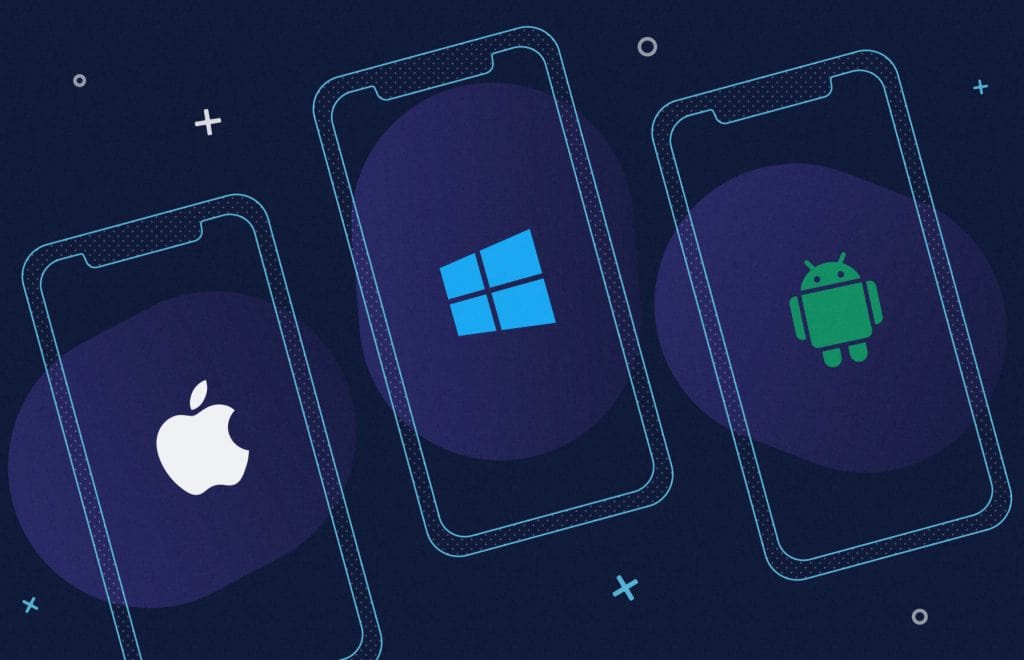
What is cross platform application
About 90% of all cell phones globally are smartphones, and the vast majority of the world’s population now possesses at least one. Currently there are over 6.5 billion smartphones in use and this number is expected to rise in the nearest future. No wonder that having a mobile application for any business, product, or service is essential. It helps to expand your target audience reach and enhance user-experience. But which platform should you use – iOS, Android, or something else? Companies must guarantee that their applications are available to customers across various mobile platforms. That’s where cross-platform applications come into play.
What is cross platform application?
A cross-platform application is a type of mobile solution that are compatible with more than one platform. It allows for developing a single application that functions seamlessly across various operating systems. Unlike native app which are specifically designed for a certain platform, cross-platform can reach a broader audience without requiring separate development for every platform.
The Difference between Native and Cross Platform Apps
Native apps are distinct from cross-platform apps. One noteworthy difference is that native mobile apps are only available for a particular operating system. Native applications utilize a programming language suited to a certain operating system, such as Objective-C for iOS and Java for Android, or Java and Kotlin for Android. However, the downside is that businesses need to invest in separate development teams and resources to create and maintain applications for each platform.
Cross-platform apps, on the other hand, are created using frameworks that enable code sharing and reusing across multiple platforms. That’s why such apps can be classified as multiplatform applications. The most common frameworks for cross-platform app creation are React Native, Xamarin, and Flutter. Cross-platform apps are good for optimizing resources, as businesses can use a single development team and codebase for several platforms. While they may not always match the performance of native apps, cross-platform solutions have come a long way and now provide a robust and seamless user experience.
Choosing Tools for Cross Platform App Development
When it comes to developingcross-platform applications, businesses have several options in terms of frameworks and tools. As mentioned before, the most popular frameworks include:
- React Native. A widely adopted framework that allows developers to create native-like apps using JavaScript and React. It offers a rich ecosystem of libraries and pre-built components, making it easier to create cross-platform applications.
- Xamarin by Microsoft. It enables developers to build cross-platform apps using C#, and provides a native user interface alongside access to platform-specific APIs, resulting in high-performance applications.
- Flutter by Google is gaining popularity due to its ability to create high-performance applications with a single codebase. It uses Dart as programming language and provides a rich set of widgets and tools.
Selecting a Vendor for Developing Cross Platform Apps
Not every company has a dedicated IT unit in their structure. Furthermore, with so many options for selecting a vendor to develop cross-platform application, this is no need for this anymore. The only thing that matters is that you select the right vendor for cross platform app development outsourcing. It is crucial for ensuring a successful project outcome. What should you consider when selecting a vendor?
- Experience and Expertise. Before making a final choice, examine your potential vendor’s portfolio and ensure a proven track record in cross-platform app development. Check client testimonials and reviews to assess their expertise in delivering cross-platform applications.
- Technology Stack. Ensure that the vendor has experience working with the cross-platform frameworks and tools you need. They should be well-versed in the latest trends and best practices in cross-platform app development.
- Custom Web App Development. If your project requires integrating a cross-platform app with existing web applications or APIs, make sure the vendor has experience incustom web app development. This will ensure seamless integration and data synchronization across different platforms.
- Software Re-engineering & Migration. If you are considering migrating an existing application to a cross-platform solution, choose a vendor with expertise in software re-engineering and migration. They should be able to assess your current application and provide insights on the feasibility and benefits of cross-platform migration.
Summing up, cross-platform applications have become essential for businesses aiming to reach a broader audience across multiple platforms. They are efficient in resource optimizing and taking user-experience to a different level. For businesses it is now essential diving deep into nuances of cross-platform application development. However, it is essential to understand the basics, such as the differences between native and cross-platform apps, choosing the right tools, and selecting a reliable vendor.
With a solid foundation in technology, backed by a BIT degree, Lucas Noah has carved a niche for himself in the world of content creation and digital storytelling. Currently lending his expertise to Creative Outrank LLC and Oceana Express LLC, Lucas has become a... Read more